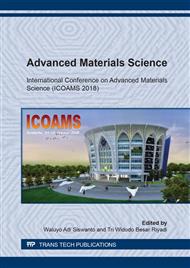[1]
K. Rahul, H.M. Shetty, N.K. Madhyastha, P.B. Kumara, K.P. D'Souza, L. D'Souza, Processing and characterisation of banana fiber reinforced polymer nano composite, Nanoscience and Nanotechnology, 7 (2017) 34-37.
Google Scholar
[2]
L. Lassila, S. Garoushia, K.V. Pekka, E. Sailynoja, Mechanical properties of fibre reinforced restorative composite with two distinguished fibre length distribution, J Mech Behav Biomed Mater. 60 (2016) 331-338.
DOI: 10.1016/j.jmbbm.2016.01.036
Google Scholar
[3]
P. Asokan, M. Firdoous, W. Sonal, Properties and potential of bio fibres, bio binders, and bio composites, Rev. Adv. Mater. Sci. 30 (2012) 254-261.
Google Scholar
[4]
M.M. Farag, Quantitative methods of materials substitution: Application to automotive components, Mater Des. 29 (2008) 374-378.
Google Scholar
[5]
A. O'Donnell, M.A. Dweib, R.P. Wool, Natural fiber composites with plant oil-based resin, Comp. Sci. Technol. 64 (2004)1135-1145.
DOI: 10.1016/j.compscitech.2003.09.024
Google Scholar
[6]
Purnomo, M. Subri, P.H. Setyarini, Fracture development and deformation behavior of zeolite-filled high density polyethylene annealed composites in the plane stress fracture, FME Transactions 46 (2018) 165-170.
DOI: 10.5937/fmet1802157z
Google Scholar
[7]
Purnomo, P.H. Setyarini, Atmospheric-pressure annealing effect on the impact fracture toughness of injection-molded zeolite-HDPE composite, International Review of Mechanical Engineering 12 (2018) 556-562.
DOI: 10.15866/ireme.v12i6.15034
Google Scholar
[8]
Purnomo, M.,Subri, Post-yield fracture behavior of zeolite-reinforced high density polyethylene annealed composite, International Review of Mechanical Engineering 11 (2017) 87-93.
DOI: 10.15866/ireme.v11i1.10542
Google Scholar
[9]
Purnomo,,R. Soenoko, A. Suprapto, Y.S. Irawan, Impact fracture toughness evaluation by essential work of fracture method in high density polyethylene filled with zeolite, FME Transactions 44 (2016) 180-186.
DOI: 10.5937/fmet1602180p
Google Scholar
[10]
A.J. Siddiqa, K. Chaudhury, B. Adhikari, Hydrophilic low density polyethylene (ldpe) films for cell adhesion and proliferation, Res. Rev. J. Med. Chem. 1 (2015) 43-54.
Google Scholar
[11]
R. Dhabale, V.S. Jatti, A bio-material: mechanical behaviour of LDPE-Al2O3-TiO2, IOP Conf. Ser.: Mater. Sci. Eng. 149 (2016) 012043.
DOI: 10.1088/1757-899x/149/1/012043
Google Scholar
[12]
J. Bočková, L. Vojtová, R. Přikryl, J. Čechal, J. Jančář, Collagen-grafted ultra-high molecular weight polyethylene for biomedical applications, Chemical Papers, 62 (2008) 580–588.
DOI: 10.2478/s11696-008-0076-1
Google Scholar
[13]
A. Riveiro, R. Soto, J. del Val, R. Comesaña, M. Boutinguiza, F. Quintero, F. Lusquiños, J. Pou, Laser surface modification of ultra-high-molecular-weight polyethylene (UHMWPE) for biomedical applications, Appl. Surf. Sci. 302 (2014) 236-242.
DOI: 10.1016/j.apsusc.2014.02.130
Google Scholar
[14]
I. Raad, R. Reitzel, Y. Jiang, R.F. Chemaly, T. Dvorak, R. Hachem, Anti-adherence activity and antimicrobial durability of anti-infective-coated catheters against multidrug-resistant bacteria. J. Antimicro. Chemoth. 62 (2008) 746-750.
DOI: 10.1093/jac/dkn281
Google Scholar
[15]
C.C. Freytag, F.L. Thies, W. König, T. Welte, Prolonged application of closed in-line suction catheters increases microbial colonization of the lower respiratory tract and bacterial growth on catheter surface, Infection 31 (2003) 31-37.
DOI: 10.1007/s15010-002-3066-1
Google Scholar
[16]
P.N. Khanam, M.A. AlMaadeed, Processing and characterization of polyethylene-based composites, Adv. Manuf.: Polym. Compos. Sci. 1 (2015) 63-79.
Google Scholar
[18]
Z. Sheikh, S. Najeeb, Z. Khurshid, V. Verma, H. Rashid, M. Glogauer, Biodegradable materials for bone repair and tissue engineering applications, Materials (Basel) 8 (2015) 5744–5794.
DOI: 10.3390/ma8095273
Google Scholar
[19]
P. Szymczyk, G. Ziółkowski, A. Junka, E. Chlebus, Application of ti6al7nb alloy for the manufacture of biomechanical functional structures (bfs) for custom-made bone implants, Materials 11 (2018) 971.
DOI: 10.3390/ma11060971
Google Scholar
[20]
A.B. Martinez, J.Gamez-Perez, M.Sanchez-Soto, J.I. Velasco, O.O. Santana, M.Ll Maspoch, The Essential Work of Fracture (EWF) method – analyzing the post-yielding fracture mechanics of polymers, Eng. Fail. Anal.16 (2009) 2604–2617.
DOI: 10.1016/j.engfailanal.2009.04.027
Google Scholar
[21]
F.M. Peres, J.R. Tarpani, C.G. Schön, Essential Work of Fracture testing method applied to medium density polyethylene, Procedia Mater. Sci. 3 (2014) 756–763.
DOI: 10.1016/j.mspro.2014.06.124
Google Scholar
[22]
T. Kuno, Y. Yamagishi, T. Kawamura, K. Nitta, Deformation mechanism under essential work of fracture process in polycyclo-olefin materials, Express Polym Lett. 2 (2008) 404-412.
DOI: 10.3144/expresspolymlett.2008.49
Google Scholar
[23]
T. Vu-Khanh, Impact fracture characterization of polymer with ductile behavior, Theor Appl Fract Mech. 21 (1994) 83–90.
DOI: 10.1016/0167-8442(94)00027-1
Google Scholar
[24]
T. Vu-Khanh, The impact fracture of polymers: unanswered question, Trends in Pol. Sci. 5 (1997) 356–360.
Google Scholar
[25]
I. Gonzalez, J.I. Eguiazabal, J. Nazabal, On the use of the essential work of fracture procedure in the determination of the fracture energy of tough polymeric materials, Polym Test 28 (2009) 760–763.
DOI: 10.1016/j.polymertesting.2009.06.008
Google Scholar
[26]
C.R. Bernal, P.M. Frontini, Determination of fracture-toughness in rubber-modified glassy-polymers under impact conditions, Polym. Eng Sci. 35 (1995) 1705–1712.
DOI: 10.1002/pen.760352107
Google Scholar


